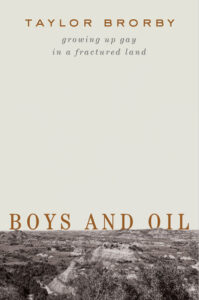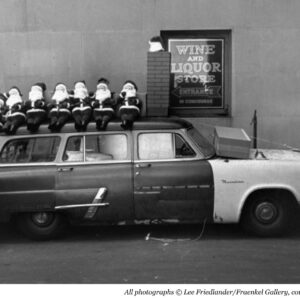
Growing Up Gay on the Oil-Rich Prairie of North Dakota
Taylor Brorby: “The story of North Dakota is then the story of self-destruction.”
Center is a place where people only end up. Socked in south-central North Dakota, located in the middle of Oliver County, Center is a stone’s throw from the 100th meridian, the rod of aridity that cleaves America between the luscious greens of the East and the mottled browns of the West. My hometown is where great trapeziums of buttes begin to break against the wash of sky. It’s the small county seat and the only incorporated town. Center is where farmers begin to get supplanted by ranchers. Fields flow into mines; it is where dust kicks up. Center is an ecotone, a transitory region of change. As the town motto reminds visitors, “It’s better in Center.”
There is no stoplight in Center, no grocery store. Such necessities as milk, Hot Stuff pizza, and two-liter bottles of Coke are purchased at the Corner Stop, the one gas station in the county. When I was small, growing up in a trailer house on the south side of Center, it took me all of ten minutes to pedal my bicycle across town to Grandpa and Grandma Brorby’s.
I went to the one school in the county with the same twenty-two other students in my grade—a lopsided division of six girls and sixteen other boys. There are two bars, a bank, a courthouse, and the small Coal Country Community Health Center on Center’s main street. There are three churches but not even a motel.
As a child, though, my world didn’t feel small. I played baseball and spent my afternoons with Grandpa Hatzenbihler fishing for bluegills or picking tart chokecherries. I wandered the grassy banks of the small Square Butte Creek, a squiggly stream that eventually empties into the wide Missouri River, looking for muskrat, heron, or beaver. Sometimes I’d spot a coyote loping in the distance.
The prairie I grew up on teaches you to notice, to pay attention—the yolk of the sun as it slides across the dome of sky, streaking the world orange and indigo, the swish of grass in the afternoon breeze, the screech of a grackle.
During the “golden hour” on the prairie, the North Dakota palette reveals the subtle differences between ocher and umber and sienna.
And North Dakota can also be biblical in terms of the weather—hailstones hurl from the sky, rain floods fields, tornadoes rip across the hills, blizzards kill cattle, heat chars crops.
To the west of Center, a large dragline lumbers on as it breaks the soil, ripping lignite coal from underground.
The men in Center fill the pews on Sunday, and on Monday are back at the mine or at the power plant, digging in the ground, heaving coal into large boilers, sending electricity to eastern North Dakota and western Minnesota. The men call Oliver County God’s Country—a land filled with ring-necked pheasants, deer, red-winged blackbirds. It’s Eden, it’s brimming, it’s full of life. But each Monday, and every day after, the men stumble into the two bars, their sooted hands grip cold beer, warm whiskey.
Each year North Dakota ranks first in binge drinking. High schoolers sneak bottles to hidden bonfire parties, someone shoots off the road, is memorialized by a flowered wreath and, if they were nice, a crude wooden cross, on a cottonwood tree on Highway 25, just before crossing the county line.
Drinking is a way to numb the pain, the dissonance, the sound of the dragline, the rumble of the boiler. The blasphemy of the work that lies ahead.
The story of North Dakota is then the story of self-destruction. Everything leaves North Dakota full and comes back empty. The only way I’ve understood my home is by getting out, escaping its crushing weight, watching the destruction, now from the outside.
The story of North Dakota is then the story of self-destruction. Everything leaves North Dakota full and comes back empty.
In childhood, when I escaped to the hills with my tackle box and drawing paper, I told no friends. I kept it a secret, like a coal burning in my gut. Boys liked playing smear the queer, king of the hill, and cowboys and Indians. I played, too, to fit in, hurled my body against other small-boned bodies atop lumpy snow mounds. I was reminded by my father that Brorbys never tap out.
But the prairie I escaped to was a supple whirlwind of grass tilting in the wind, a symphony of sage-grouse song. Beaver tails slapped the water. I would cast spoons for northern pike in the Square Butte Creek. When the casting became boring, I pulled out my sketchbook and pencils and traced the bend of the creek against the white paper.
I tried to create the world I wanted rather than the world as it was—a world of broken lignite and all-too-often broken people.
On the playground, I asked friends to play tag or an imaginary game of pirates. Instead, the other boys sized one another up, divided into two lines, and threw footballs. They ran back and forth across the asphalt playground, slammed the ball hard against the ground when they scored a touchdown. I watched, from a distance, wondering where I fit into the place I lived.
I still cringe when I say I played with girls, since I was constantly called a girl because I wanted to create my own games. I wanted room for my imagination.
Throughout elementary school, on Halloween those boys dressed like police officers, firefighters, and football players. I dressed, not as Barbie, but as Dracula, or a wizard, or a pirate.
Even then, I wanted a larger world.
My classmates played a preconceived game in a world that was preordained for them—chase a ball under Friday night lights, grow into men who dig coal from the ground. Save for the Mexican cruise you’ve always wanted. Retire when your body begins to break.
There was something I, too, craved in that landscape, something soft, something I couldn’t see in the human-made world. So, I headed for the hills where badgers roamed, where pheasants tucked into marshy grass. There was diversity to the natural world that I could not find in my hometown. He’s a dreamer, he’s not a hard worker, he doesn’t want to play football.
*
The prairie is best rendered in fall. In a land where light—its length, its clarity—is abundant, it is only in fall when its sheer intensity, its radiant glory, is felt. In late afternoon, as the sun slides lower in the western sky, the buttes blaze copper; the harvested fields of wheat turn tawny. The sky slowly streaks to calamine. Shadows lengthen and the world rushes toward the close of day, the golden light lasting a mere hour. It is as if you are within the brushstrokes of a fiery painting.
As the ferocity of the crepuscular light fades and darkness seeps across the vault of sky, stars shroud the edges of the wide world. It is as if fireflies are lodged into a large black sheet. Once, when I was in elementary school, while my family drove home in winter on a cold, clear night, the aurora borealis leaked into my periphery. Lime ribbons began to swirl higher and higher until the ionosphere pulsed. Vertiginous, my father pulled over and we enjoyed the silent fireworks sweeping across the sky—it felt like I was inside the birthing of a nebula.
The ocean of the prairie is too large to be captured in any one image. However much I’ve tried, no panoramic lens can give the scale of the prairie’s magnitude. The prairie cannot be summited; we cannot even go, like a forest, into it. To truly experience the prairie, we must lower ourselves and submit our bodies to the ground. We must be comfortable with soil, with earth, with dust.
The ocean of the prairie is too large to be captured in any one image.
For hours in childhood I would lie down on a hilltop beyond the wheat field behind our house. The sky washed with clouds that slowly shifted like a trail of smoke. The earth below me seemed to move, but maybe it was because of the wheeling of a hawk or the whirling of a turkey vulture high above me. I felt unmoored, floating across the sea of sky.
The prairie, too, can become unmoored. The chalky soil of western North Dakota was, in the early days of European immigration, cut into bricks to build sod houses—brick by brick, layer by layer, crude houses rose across the ocean of sage, milkvetch, and little bluestem. Like a fishnet, the grass’s roots held the sod bricks together yet were still permeable. Sometimes bull snakes fell from the ceiling onto dining tables.
But the prairie is fragile. To be of the prairie is to recognize its fragility. To some, what feels harsh and open is, upon closer examination, delicate and sensitive.
The prairie of western North Dakota does not heal. On my sojourns in southwestern North Dakota, near Amidon and Marmarth, I’ve rubbed my hands along wagon tracks still rutted in the land from Custer’s fateful trip west.
Before growing upward, grass tests the conditions to see whether it can make a home in place. Before sending up its bright blade, as much as two-thirds of the plant will vein through the soil, spreading outward and down like the branches of a tree. The grass is patient; it can take years before it decides to pop up and emerge.
This patience has been broken throughout history by various animals—horses and cattle whose hooves aren’t shaped for the arid soil of western North Dakota—and by excavation of oil and coal, which rips the roots and breaks the fibers that bind and secure soil in place.
The prairie needs time to flourish. The empire of fossil fuels moves swiftly. The prairie I know is not like the forests of New England; it does not regenerate quickly. In a culture where we spend, lose, save, and buy our time—where time is an economic transaction—the prairie teaches us that to flourish, we need patience.
When a mountaintop is removed, we see its rubble cast into the valley. When a forest is clear cut, we see the stumps like fibrous tombstones. But when the prairie is overturned, we fail to mourn because, to most of us, the prairie is dirt, a patch of grass, nothing remotely remarkable. What we cannot recognize we oftentimes will not protect.
Perhaps it is because of intimidation. Since the prairie spreads, instead of builds, we view it as no great wonder, as something we have no control over, as something that’s around and beneath us, as something we cannot conquer. But so often, at least to our way of seeing, we fail to notice what’s right at our feet. By looking down, instead of up, an entire universe reveals itself. A community of microbes, miles of roots twisting and wrapping, field mice and badger burrows.
To live on the prairie is to be hunted, whether by a coyote, by a pack of boys, or by the sting of loneliness. There is no other way to say this: the prairie reveals. Like a painting viewed at a nose’s length, layer upon layer of color, of grass, of our very selves, is exposed on the prairie. It is a place that tests us spiritually, even existentially.
The prairie is humble—supple and gentle, a purl of stiff stalks in the wind, pulsing and swaying: a large, undulating wash of brown and green against the air that, not so very long ago, was brackish and heavy. The prairie begins in stillness and slips through the soil of my imagination, a great canvas against which to paint the ideas of history, the possibilities in a broken world, a vast space that makes enough room for any idea, for any wish—a biotic community of possibility and rootedness.
The prairie is perceived as barren, and the only way to deal with emptiness is to fill it up. Space is what the prairie provides. By seeing space, we might better know the spaces within us, and how to hold and carry space. To see space is a matter of sight. With enough space, ideas have room to take root, grow, and blossom.
The prairie, for millennia, was not perceived as empty; it was a riot of life. Throngs of bison ambled across the prairie. Elk, grizzly bear, and gray and red wolves lived as far east as the Missouri River. Cougars hunted the plentiful pronghorn antelope. And then Europeans, desperate for food and clothing—and, later in the nineteenth century, for sport as well as in a systematic attempt to starve Native Americans—began a multispecies slaughter. With the megafauna of the Plains reduced, a spiritual inanition replaced a region that had once vibrated with life. The symphony of the prairie quieted.
The prairie trains the eye to be attentive. The dome of the sky smolders cerulean, sapphire, indigo, crimson, amber, saffron, lavender, periwinkle, and plum.
The level of noticing that the prairie teaches is only achieved through attentiveness and stillness, and it’s often found in solitude. Perhaps this is why many Native Americans went on their vision quests atop buttes. It is by looking out that we can finally see within.
The boundary of the mixed-grass prairie is supple. Over dozens of miles the tall grasses, such as big bluestem, which can grow to more than six feet in height, lose their grip as they are replaced by the short grasses. There is a gradual change—there is no strong boundary, but rather a gentle flow. The mixed-grass prairie of North Dakota is the geographical center—the heart—of the continent.
Yet we are a culture that plays to the edges. We are fascinated with coastal cities, with density, with, as the writer Gretel Ehrlich says, building against space. But in the great middle is the core from which everything flows. It is the center upon which everything depends. When a wound in the heart festers, rot sweeps through the body—and this rot, in a place where little attention from the wider culture is given, can replicate, if not fester, over generations, spreading to the rest of the bioregions slowly, methodically, if not metaphorically, until we all are reduced to a stubble.
___________________________

From Boys and Oil: Growing Up Gay in a Fractured Land. Used with the permission of the publisher,Liveright. Copyright 2022 by Taylor Brorby.
Taylor Brorby
Taylor Brorby is an essayist and poet. The coeditor of Fracture, his work has appeared in the Huffington Post, Orion, and North American Review, where he is a contributing editor.



















